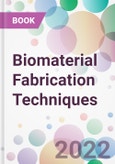These include freeze drying, electrospinning, 3D printing, multiphoton lithography, particulate leaching, supramolecular self assembly, solvent casting and melt molding. The book is an essential primer on biomaterial synthesis for students and early career researchers in the field of biomedical engineering, applied chemistry and tissue engineering.
Table of Contents
Chapter 1: Introduction To Biomaterials and Scaffolds for Tissue Engineering- Introduction
- Biomaterials for Scaffold Fabrication
- Ceramics
- Polymers
- Metals
- Composites
- Hydrogels
- Methodologies for Scaffold Production
- Scaffold Design and Properties Relationship
- Current Scaffold Fabrication Technologies
- Conclusion and Future Directions
- Consent for Publication
- Conflict of Interest
- Acknowledgement
- References
- Introduction
- Biomaterials for Tissue Engineering
- Scaffolds for Tissue Engineering
- Biomaterials for Scaffold Preparation
- Ceramics
- Bio Glass
- Alumina (Al2 O3)
- Zirconia Oxide (Zro2)
- Polymers
- Collagen and Its Derivatives
- Polysaccharides
- Synthetic Polymers
- Metals
- Stainless Steel
- Composite
- Hydrogel
- Natural Hydrogels
- Synthetic Hydrogels
- Semi-Synthetic Hydrogels
- Durable Hydrogels
- Biodegradable Hydrogels
- Techniques Used for the Preparation of Scaffolds
- Solvent Casting / Particulate Leaching
- Melt Molding / Particulate Leaching
- Gas Foaming
- Phase Inversion / Particulate Leaching
- Fiber Bonding
- Freeze Drying Method
- Solid Free Form Fabrication
- Three Dimensional Printing
- Fused Deposition Modeling
- Conclusion
- Consent for Publication
- Conflict of Interest
- Acknowledgement
- References
- Introduction
- The Freeze-Drying Process
- Controlled Freezing
- Directional Freezing
- Spray-Freezing Into Liquid (Sfl)
- Porous Structures
- Aqueous Solutions
- Aqueous Colloidal Suspensions
- Organic Solutions
- Emulsions
- Micro- and Nanowires
- Micro- and Nanoparticles
- Potential Application of Freeze Drying
- Conclusion and Prospects
- Consent for Publication
- Conflict of Interest
- Acknowledgement
- References
- Introduction
- Conventional Fabrication Techniques
- Electrospinning Technique
- Melt Blowing Technique
- Bicomponent Fibre Spinning
- Phase Separation Technique
- Template Synthesis Technique
- Self-Assembly Technique
- Limitation of Conventional Techniques
- Centrifugal Spinning
- Centrifugal Spinning Systems
- Rotating Head
- Nanofiber Collecting System
- Types of Centrifugal Spinning Nanofibers
- Polymer Nanofibers
- Carbon Nanofibers
- Ceramic Nanofibers
- Processing Centrifugal Spinning
- Fluid Properties
- Operational Conditions
- Introduction of Sbs
- Application in Tissue Engineering
- Synthetic Extracellular Matrix
- Biological Response To Nanofibrous
- Conclusion and Prospects
- Consent for Publication
- Conflict of Interest
- Acknowledgement
- References
- Introduction
- Fundamental Aspects of Electrospinning
- Electrospinning Techniques for Esnfs Fabrication
- Blending Electrospinning
- Coaxial Electrospinning
- Emulsion Electrospinning
- Melt Electrospinning
- Materials Used for Fabrication of Esnfs
- Parameters Affect Electrospinning
- Solution Parameters
- Processing Parameters
- Environmental Parameters
- Mechanisms of Drug Loading Into Esnfs
- Blending Method
- Core/Sheath Method
- Encapsulation Method
- Attachment Method
- Characterization of Esnfs
- Physical Characterization
- Morphology
- Surface Area
- Tool Used for Chemical Characterization of Esnfs
- Biomedical Applications of Esnfs
- Esnfs as Drug Delivery Carrier
- Esnfs in Tissue Engineering
- Esnfs in Wound Healing
- Esnfs in Cancer Therapy
- Esnfs for Dentistry Applications
- Esnfs in Imaging and Biosensing for Disease Diagnostics/Prognosis
- Esnfs in Membranes for Medical Filtration and Dialysis
- Conclusion
- Consent for Publication
- Conflict of Interest
- Acknowledgement
- References
- Introduction
- Three-Dimensional Printing (3Dp) Technologies
- 3D Printing Types in Biomedical Applications
- Powder-Based Printing
- Liquid Reservoir
- Sheets of Material
- Nanofabrication
- Biocompatible 3D Printing Materials
- Bioinks
- Biomaterial Inks
- Synthetic Hydrogels
- Thermoplastics and Resins
- Ceramics
- Metal Implants
- Healthcare Applications
- Tissue Engineering
- 3D Models and Organoids
- Implants
- Tissue Regeneration
- Implant-Tissue Interface
- Dentistry
- Orthopedics
- Drug Delivery
- Tablets
- Transdermal Delivery
- Drug-Releasing Implants
- Surgical Tools
- Conclusion
- Consent for Publication
- Conflict of Interest
- Acknowledgements
- References
- Introduction
- Multiphoton Lithographic Photopolymerization
- Multiphoton Polymerization Tools for the Synthesis of Biomaterials
- Chemistry of Mpl Photopolymerization
- Photo Polymerization
- Photoinitiators
- Photopolymer Chemistry
- Photochemical Decomposition and Polymerization
- Initiator-Facilitated Photo Polymerization
- Photocage-Facilitated Photoconjugation
- General Photoconjugation
- Light-Induced Decomposition
- Revocable Photoconjugation
- Applications
- Biomaterials Synthesis
- Modulation of Biological Materials
- Limitations of Mpl To Biological Design
- Conclusion
- Consent for Publication
- Conflict of Interest
- Acknowledgement
- References
- Introduction
- Particulate Leaching (Salt Leaching) Technique
- Polymers
- Salt
- Methods
- 1. Conventional Salt Leaching
- 2. Combination of Melt Mixing and Particulate Leaching
- 3. High Compression Molding-Salt Leaching
- 4. Gas Foaming-Salt Leaching
- 5. Salt Leaching Electrospinning (Sle)
- 6. Salt Leaching Using Powder (Slup)
- Advantage and Disadvantage of Scaffolds Produced By Salt Leaching Technique
- Physical and Mechanical Characteristics
- 1. Pore Size
- 2. Porosity
- 3. Mechanical Properties
- 4. Interconnected 3D Structures
- Biomaterials Prepared With Particulate Leaching Technique
- Porous 3D Scaffold Applications With Salt Leaching Technique
- Bone Engineering
- Neuronal Retinal Precursor Cells
- Skin Substitutes
- Future Prospect
- Concluding Remark
- Consent for Publication
- Conflict of Interest
- Acknowledgement
- References
Author
- Adnan Haider
- Sajjad Haider








